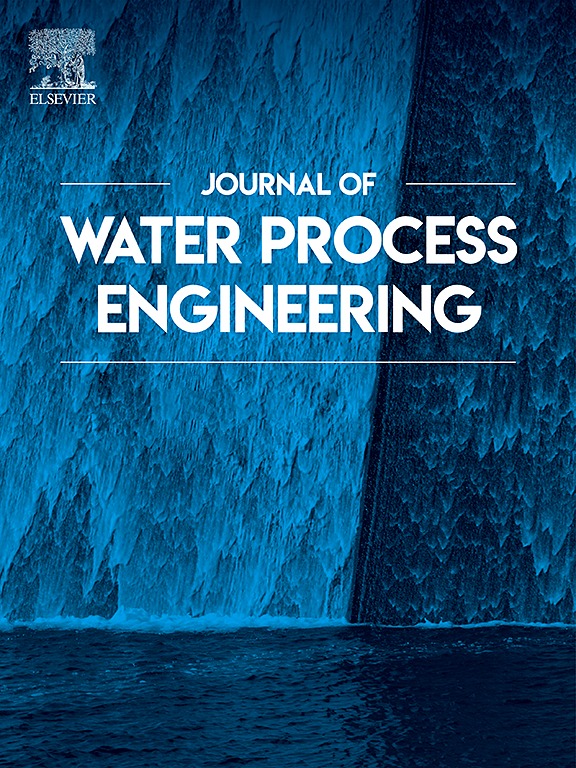利用UV/H2O2和UV/PMS对真实牲畜废水进行营养高效回收:动力学研究和统计优化
IF 6.7
2区 工程技术
Q1 ENGINEERING, CHEMICAL
引用次数: 0
摘要
每年产生1亿立方米的牲畜废水,其特点是高水平的可生物降解和难降解有机物和高氮含量。鉴于水资源短缺和对肥料的需求不断增加,以养分回收为重点的高效废液处理对于农业中水的回用至关重要。本研究通过分析不同的摩尔比(TOC/Ox: 1:0.75, 1:1, 1:2, 1:4),评估了高级氧化过程(AOP)、UV/H₂O₂和UV/过氧单硫酸盐(UV/PMS)的动力学构型和统计优化。该研究评估了硝酸盐(NO₃-N)的生成和总凯氏定氮(TKN)的还原。在TOC/Ox = 1:2时,UV/H₂O₂工艺使NO₃-N增加了18.32倍,而在TOC/Ox = 1:4时,UV/PMS工艺使NO₃-N增加了10.63倍。这是由于有机质破碎和NH3-N被自由基(∙OH和SO₄)氧化所致。-)。动力学分析显示零级拟合(R2 >;UV/H₂O₂拟合为0.93),UV/PMS拟合为伪二阶拟合(R2 = 0.98)。结果表明,氧化剂浓度和摩尔比显著影响硝酸盐的生成(P <;0.05),可达到初始浓度的29倍。这一方法有助于可持续的LWW管理,并促进负责任的农业做法。本文章由计算机程序翻译,如有差异,请以英文原文为准。

Nutrient-efficient recovery process from real livestock wastewater using UV/H2O2 and UV/PMS: Kinetic study and statistical optimization
Annually, 100 million m3 of livestock wastewater (LWW) are generated, characterized by high levels of biodegradable and recalcitrant organic matter and a high nitrogen content. Given water scarcity and the increasing demand for fertilizers, efficient LWW treatment focusing on nutrient recovery is crucial for water reuse in agriculture. This study evaluates the kinetic configuration and statistical optimization of advanced oxidation processes (AOP), UV/H₂O₂, and UV/Peroxymonosulfate (UV/PMS), analyzing different molar ratios (TOC/Ox: 1:0.75, 1:1, 1:2, 1:4). The study assessed nitrate (NO₃-N) generation and total Kjeldahl nitrogen (TKN) reduction. The UV/H₂O₂ process achieved an 18.32-fold increase in NO₃-N at TOC/Ox = 1:2, while UV/PMS achieved a 10.63-fold increase at TOC/Ox = 1:4. This is attributed to organic matter fragmentation and NH3-N oxidation by free radicals (∙OH and SO₄. -). The kinetic analysis showed a zero-order fit (R2 > 0.93) for UV/H₂O₂ and a pseudo-second-order fit for UV/PMS (R2 = 0.98). It was determined that oxidant concentration and molar ratio significantly influence nitrate generation (P < 0.05), achieving up to 29 times the initial concentration. This approach contributes to sustainable LWW management and promotes responsible agricultural practices.
求助全文
通过发布文献求助,成功后即可免费获取论文全文。
去求助
来源期刊

Journal of water process engineering
Biochemistry, Genetics and Molecular Biology-Biotechnology
CiteScore
10.70
自引率
8.60%
发文量
846
审稿时长
24 days
期刊介绍:
The Journal of Water Process Engineering aims to publish refereed, high-quality research papers with significant novelty and impact in all areas of the engineering of water and wastewater processing . Papers on advanced and novel treatment processes and technologies are particularly welcome. The Journal considers papers in areas such as nanotechnology and biotechnology applications in water, novel oxidation and separation processes, membrane processes (except those for desalination) , catalytic processes for the removal of water contaminants, sustainable processes, water reuse and recycling, water use and wastewater minimization, integrated/hybrid technology, process modeling of water treatment and novel treatment processes. Submissions on the subject of adsorbents, including standard measurements of adsorption kinetics and equilibrium will only be considered if there is a genuine case for novelty and contribution, for example highly novel, sustainable adsorbents and their use: papers on activated carbon-type materials derived from natural matter, or surfactant-modified clays and related minerals, would not fulfil this criterion. The Journal particularly welcomes contributions involving environmentally, economically and socially sustainable technology for water treatment, including those which are energy-efficient, with minimal or no chemical consumption, and capable of water recycling and reuse that minimizes the direct disposal of wastewater to the aquatic environment. Papers that describe novel ideas for solving issues related to water quality and availability are also welcome, as are those that show the transfer of techniques from other disciplines. The Journal will consider papers dealing with processes for various water matrices including drinking water (except desalination), domestic, urban and industrial wastewaters, in addition to their residues. It is expected that the journal will be of particular relevance to chemical and process engineers working in the field. The Journal welcomes Full Text papers, Short Communications, State-of-the-Art Reviews and Letters to Editors and Case Studies
 求助内容:
求助内容: 应助结果提醒方式:
应助结果提醒方式:


